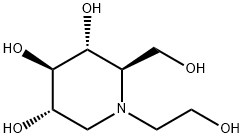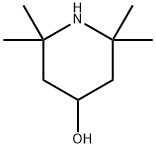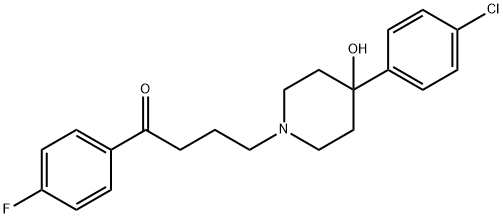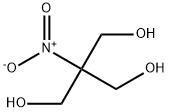Miglitol
Synonym(s):1-(2-Hydroxyethyl)-2-(hydroxymethyl)piperidine-3,4,5-triol
- CAS NO.:72432-03-2
- Empirical Formula: C8H17NO5
- Molecular Weight: 207.22
- MDL number: MFCD00867240
- EINECS: 276-661-6
- SAFETY DATA SHEET (SDS)
- Update Date: 2023-07-04 17:14:15

What is Miglitol ?
Absorption
Absorption of miglitol is saturable at high doses with 25 mg being completely absorbed while a 100-mg dose is only 50-70% absorbed. No evidence exists to show that systemic absorption of miglitol adds to its therapeutic effect.
Toxicity
Unlike sulfonylureas or insulin, an overdose will not result in hypoglycemia. An overdose may result in transient increases in flatulence, diarrhea, and abdomi-nal discomfort. Because of the lack of extra-intestinal effects seen with miglitol, no serious systemic reactions are expected in the event of an overdose.
Description
Miglitol was introduced in Germany as an auxiliary treatment for non-insulin dependent diabetes (NIDDM). A simple two-step synthesis of Miglitol consists of converting 6-desoxy-6-aminosorbose into desoxynojirimycin by reductive cyclization, then selectively hydroxyethylating the cyclic nitrogen. Miglitol is a short-acting intestinal alpha-D-glucosidase inhibitor, reducing postprandial glucose excursions by helping to delay absorption of complex carbohydrates. Acarbose and voglibose are the previous compounds marketed in this class. At low doses, orally administered miglitol was shown to be rapidly and completely absorbed then removed by renal excretion.
The Uses of Miglitol
An inhibitor of alpha-glucosidases.
Background
Miglitol inhibits the breakdown complex carbohydrates into glucose. It is primarily used in diabetes mellitus type 2 for establishing greater glycemic control by preventing the digestion of carbohydrates (such as disaccharides, oligosaccharides, and polysaccharides) into monosaccharides which can be absorbed by the body.
Miglitol should be taken at the start of a meal for maximal effect and the effect will depend on the amount of poly and oligosaccharides in the diet. Miglitol inhibits alpha-glucosidase, making less sugars available for digestion and reducing postprandial hyperglycemia.
Unlike other drugs of the same class, miglitol is not metabolized and the unmetabolized drug is excreted by the kidneys.
Indications
For use as an adjunct to diet to improve glycemic control in patients with non-insulin-dependent diabetes mellitus (NIDDM) whose hyperglycemia cannot be managed with diet alone.
What are the applications of Application
Miglitol is an antidiabetic compound
Pharmacokinetics
Miglitol, an oral alpha-glucosidase inhibitor, is a desoxynojirimycin derivative that delays the digestion of ingested carbohydrates, thereby resulting in a smaller rise in blood glucose concentration following meals. As a consequence of plasma glucose reduction, miglitol reduce levels of glycosylated hemoglobin in patients with Type II (non-insulin-dependent) diabetes mellitus. Systemic nonenzymatic protein glycosylation, as reflected by levels of glycosylated hemoglobin, is a function of average blood glucose concentration over time. Because its mechanism of action is different, the effect of miglitol to enhance glycemic control is additive to that of sulfonylureas when used in combination. In addition, miglitol diminishes the insulinotropic and weight-increasing effects of sulfonylureas. Miglitol has minor inhibitory activity against lactase and consequently, at the recommended doses, would not be expected to induce lactose intolerance.
Metabolism
Miglitol is not metabolized in man or in any animal species studied.
Properties of Miglitol
| Melting point: | 114°C |
| Boiling point: | 453.7±45.0 °C(Predicted) |
| Density | 1.458±0.06 g/cm3(Predicted) |
| storage temp. | Sealed in dry,Store in freezer, under -20°C |
| solubility | Soluble in DMSO (up to 50 mg/ml with warming), or in Water (up to 60 mg/ml). |
| form | solid |
| color | White |
| Water Solubility | Soluble |
Safety information for Miglitol
| Signal word | Warning |
| Pictogram(s) |
 Exclamation Mark Irritant GHS07 |
| GHS Hazard Statements |
H315:Skin corrosion/irritation H319:Serious eye damage/eye irritation |
| Precautionary Statement Codes |
P305+P351+P338:IF IN EYES: Rinse cautiously with water for several minutes. Remove contact lenses, if present and easy to do. Continuerinsing. |
Computed Descriptors for Miglitol
| InChIKey | IBAQFPQHRJAVAV-ULAWRXDQSA-N |
Abamectin manufacturer
Varanous Labs Pvt Ltd
New Products
3-N-BOC-(S)-AMINO BUTYRONITRILE 4-Piperidinopiperidine 2-Methyl-4-nitrobenzoic acid 2-(4-bromophenyl)-2-methylpropanoic acid 4-Acetyl-2-methylbenzoicacid Acetyl-meldrum's acid Ethyl-4-Pyrazole carboxylate 2,6 Di acetylpyridine 2,6-Pyridinedimethanol 5,7-Dichloro-3H-Imidazo[4,5-B]Pyridine 5-Bromo-2-Methoxy-4-Methyl-3-Nitropyridine 2-Fluoro-5-Iodopyridine 2-Fluoro-5-Methylpyridine 2-Chloro-3-Bromo-5-Amiopyridine METHYL-4-(BUTYRYLAMINO)3-METHYL-5-NITROBENZOATE TRANS-CYCLOBUTANE-1,2- DICARBOXYLIC ACID 5-Nitro indazole R-(-)-5-(2-AMINO-PROPYL)-2-METHOXY-BENZENESULFONAMIDE 1,3-cyclohexanedione 4-Aminophenaethylalchol 3-NITRO-5-ACETYL IMINODIBENZYL (S)-(+)-4-BENZYL-2-OXAZOLIDINONE 4-FLUORO PHENYL MAGNESIUM BROMIDE 1.0 M IN THF 1-HYDROXY-4-METHYL6-(2,4,4-TRI METHYL PHENYL)-2-PYRIDONE MONO ETHANOL AMINE(PIROCTONE OLAMINE)Related products of tetrahydrofuran








You may like
-
 72432-03-02 Miglitol 98%View Details
72432-03-02 Miglitol 98%View Details
72432-03-02 -
 72432-03-2 98%View Details
72432-03-2 98%View Details
72432-03-2 -
 68915-31-1 99%View Details
68915-31-1 99%View Details
68915-31-1 -
 Azadirachtin 11141-17-6 99%View Details
Azadirachtin 11141-17-6 99%View Details
11141-17-6 -
 26062-79-3 99%View Details
26062-79-3 99%View Details
26062-79-3 -
 Geraniol 99%View Details
Geraniol 99%View Details
106-24-1 -
 BENZALKONIUM CHLORIDE BKC 99%View Details
BENZALKONIUM CHLORIDE BKC 99%View Details
8001-54-5 -
 Amrit Neem 11141-17-6 99%View Details
Amrit Neem 11141-17-6 99%View Details
11141-17-6